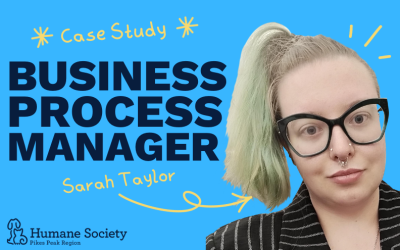Do you ever get clients that ask for more than what was agreed? They just keep adding to the scope of work by asking “can you do this for me?” “can you do that?” “here’s a small thing, can you help?
As we all know, the more you say “yes” upfront, the harder it becomes to say “no.” And a once profitable project quickly turns unprofitable.
So what causes scope creep and more importantly how do you fix it?
The problem is caused by lack of clarity. Clarity for you and your clients around what you’re doing and what you’re not doing. The trick is to clearly define your deliverables upfront so everyone is on the same page. This helps you stay on track.
In this video, David Jenyns shares his insights on how to best avoid scope creep.
Timestamps:
0:13 What is scope creep in project management?
0:54 Time vampire clients.
1:30 What causes scope blowout?
2:40 How to gain clarity in project management.
3:50 Define the scope of work based on the Critical Client Flow.
4:11 Underpromise what you’re going to give the client and then overdeliver.
4:44 Project management scope of work document
5:15 It’s hard for the client to dispute it, because it was agreed upon.
6:15 Limiting your scope will skyrocket your client satisfaction.
Transcription:
Here’s how you can stop scope creep. When I was a consultant, I saw it all the time, particularly when I started my systems consulting business. I would start with a project, two months later, the workload expands.
Sometimes you don’t even notice it—it’s in the name, scope creep. It creeps up on you. It’s a little thing here, a little thing there. How can we do this? And unless you have a way to manage it, it can become really frustrating and overwhelming for you and the client.
Once you say yes a couple of times, then you condition them that you’ll say yes all of the time. And then it becomes awkward if you need to say “no” or “that’s outside of scope.”
You want to think about this stuff upfront because it turns a profitable project unprofitable. It sets that expectation and allows for what I call time vampire clients. They basically suck your time and they’re the ones that always bang the loudest on the drum to get your attention they’ll be calling you directly and they just want everything done for them.
What ends up happening is you get to the point where it’s just a painful client when they call. And those clients, not only do they not feel great, but they become horrible for repeat work and also referrals.
So it’s a problem that you’re so much better off solving and preparing for upfront. It builds perfectly into the idea of this Trojan horse offer because what causes scope blowout? What do you feel causes scope blowout? Is it the expectations that you set for the client? Is it not clear? Is it just the nature of the beast? Is consulting work a situation where there’s always going to be a scope blowout?
Lack of clarity on time task territory. You need a very clear scope upfront. You can imagine what it was like when I started my systems consulting business. Systems consulting—where are the edges on that?
“I want this system. You said you were going to come in and systemise my business. And I feel like now I’ve got all of these other departments and other parts of my business that need to be systemised.”
How do you put the bookends on that? That was something I kind of struggled with for my first few clients until I realised exactly what the problem was and it was around this lack of clarity. Once you identify what your Trojan horse offer is, part of that is making sure that the offer solves a very specific problem for the client.
Once you know that you’re solving a specific problem, it makes it easier to define what the deliverables are at a clearly established timeline and you want to agree to all of this upfront. That way, it becomes much easier when the client goes off track and says, “oh, can you do this and that,” and then nudges you.
It’s much easier for you to come back to that document and say here’s what it is that we’ve agreed on. Because the only reason that there is a problem is the client has a picture in their head of what they’re imagining you’re doing. You have a different picture in your head of what you’re doing and that misalignment is creating the problem.
One thing with me when it comes to clients, I’m a little bit of a people pleaser. In the early days, I wanted to go above and beyond, and I always do. But that was easy for certain people because I didn’t know how to rein it in. And for people to take advantage of that and just ask for a little bit more and a little bit more.
So what I ended up developing was the critical client flow—that first three-month engagement with a client. We define the scope of work based on the critical client flow and we agree this is what we’re doing. And as part of that process, I’m trying to underpromise what I’m going to give the client, which then makes it easier to over-deliver.
I always find I’m infinitely better off to underpromise and create more systems and go above and beyond what they’re expecting and then they feel great about it. I started off getting this very clear document and you want to be thinking about the same. You think about your Trojan horse offer, and the clear deliverables and you think about how you use that in the selling process and how you use that as you’re going through delivery.
I would then transfer that into this scope of work document—a spreadsheet where we would identify what the systems are that we would be working on. Anytime that the client asked for something that was outside of the agreed upon works, then it would appear underneath “coming soon”. And with that, we’ve got our order of priority, we know what it is that we’re working on.
Let’s work on this first and let’s capture that idea because it’s a great idea and we’ll circle back around to that at the end of that initial engagement. It’s hard for the client to dispute because it was agreed upon. Of course, it’s a clarity and aligns your thinking with their thinking. You’ll often get the client to sign off on what they don’t want also. And then that brings clarity, which is a great idea, maybe you introduce into the conversation this idea that at the moment you have loads of leads, so leads aren’t your problem.
So we don’t need to worry about focusing on your lead generation systems just yet. I think that’s a great way to do it, identifying where the pain is for them and let’s focus on solving and fixing that pain rather than opening up the scope of works.
Again, everything that I’m sharing with you, I want you to run it through your own filter, think about it in terms of your own business and how can you just take these ideas and you’ll find, particularly this one around customer satisfaction and limiting scope, it will skyrocket your customers satisfaction.
I started doing that after my early clients, it enabled me to over deliver on the promises and this became a core part of the way that I market systemology. I feel like the best proof is always the proof of the clients who had the problem, worked with us, got a fantastic result and are now happy to share that. By defining that scope of work, you can even build that into your sales process at the end of this.
Once I deliver on this and you absolutely love it and we solve this problem for you, I would love to tell you a story, to have other people who are in a similar situation hear your story and then go “oh yeah, this could work for me too.”










